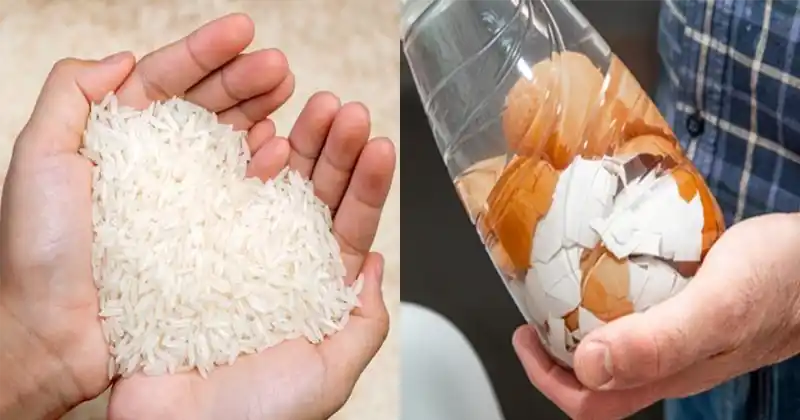2 DIY Fertilizers Every Gardener Needs: Eggshells and Rice Water

Gardening can sometimes feel overwhelming, especially when you’re a beginner trying to nurture your plants. The good news? You don’t have to spend a lot of money on fancy fertilizers. Two of the best homemade fertilizers can be made using items you probably already have in your kitchen: eggshells and rice water. These natural, nutrient-packed fertilizers are perfect for boosting your plants’ health without any harsh chemicals. Let’s dive into how you can make and use them, along with the benefits they offer.
1. Eggshell Fertilizer: Calcium Powerhouse
Eggshells are one of the most underrated kitchen scraps that can transform your garden soil. They are rich in calcium carbonate, the same ingredient found in agricultural lime, and provide a steady supply of calcium to your plants.
How to Make Eggshell Fertilizer
- Collect and Clean: Gather your leftover eggshells. Make sure to rinse them thoroughly to remove any egg residue.
- Dry the Eggshells: Spread the eggshells on a baking sheet and leave them to dry naturally for a few days. If you’re in a hurry, bake them at a low temperature (about 200°F or 95°C) for 10-15 minutes.
- Crush or Powder the Eggshells: Once dry, crush the eggshells into small pieces using your hands, a mortar and pestle, or a blender for a finer powder.
How to Use Eggshell Fertilizer
- As a Soil Additive: Mix crushed or powdered eggshells directly into your garden soil. This is especially effective for plants like tomatoes, peppers, and eggplants, which can suffer from calcium deficiencies (e.g., blossom end rot).
- As a Top Dressing: Sprinkle a handful of crushed eggshells around the base of your plants. This method is slower but provides a gradual release of calcium as the eggshells decompose.
Eggshell Tea Fertilizer
Another great way to use eggshells is to make eggshell tea, which allows plants to absorb the nutrients more quickly.
How to Make Eggshell Tea:
- Boil Water: Bring a pot of water to a boil (around 1 liter or 4 cups of water).
- Add Crushed Eggshells: Add 10-12 crushed eggshells to the boiling water.
- Steep and Cool: Turn off the heat and let the mixture steep for 24 hours.
- Strain: Strain the liquid to remove the eggshell pieces.
- Use the Tea: Pour the eggshell tea directly onto the soil around your plants.
Benefits of Eggshell Fertilizer
- Calcium Boost: Helps strengthen cell walls, promoting healthy root and stem growth.
- Prevents Blossom End Rot: Common in plants like tomatoes, peppers, and squash, this condition is caused by calcium deficiency.
- Soil pH Regulation: The calcium in eggshells can help neutralize acidic soils.
- Deters Pests: Crushed eggshells can act as a barrier to pests like slugs and snails, which avoid crawling over the sharp edges.
Tips for Using Eggshell Fertilizer
- Consistency is Key: Use eggshell fertilizer regularly, as it takes time to break down in the soil.
- Avoid Overuse: Too much calcium can disrupt the nutrient balance in your soil, so use eggshell fertilizer in moderation.
2. Rice Water Fertilizer: Nutrient-Rich Elixir
Rice water, the milky liquid left after rinsing or boiling rice, is another excellent natural fertilizer. It’s packed with essential nutrients like nitrogen, potassium, and phosphorus, making it a fantastic option for promoting plant growth.
How to Make Rice Water Fertilizer
There are two main ways to make rice water:
1. Rinsed Rice Water:
- Rinse Your Rice: Before cooking, rinse a cup of rice with 2-3 cups of water.
- Collect the Water: Strain the water into a container and save it for your plants.
2. Boiled Rice Water:
- Boil the Rice: Cook your rice as usual, but save the excess water left after boiling.
- Cool Down: Let the boiled rice water cool to room temperature before using it.
How to Use Rice Water Fertilizer
- Direct Application: Pour the rice water directly onto the soil at the base of your plants. Use it as you would with regular watering, about once a week.
- Foliar Spray: For an extra boost, transfer the rice water into a spray bottle and use it as a foliar spray on your plants’ leaves. This allows the nutrients to be absorbed more quickly.
Benefits of Rice Water Fertilizer
- Promotes Healthy Root Growth: The nutrients in rice water, especially phosphorus, help stimulate root development.
- Enhances Leaf Growth: Nitrogen in rice water boosts the production of chlorophyll, leading to greener, healthier leaves.
- Supports Beneficial Microbes: The starch in rice water feeds beneficial soil bacteria, improving soil health.
- Cost-Effective and Sustainable: Using rice water is an excellent way to repurpose kitchen waste, reducing the need for chemical fertilizers.
Tips for Using Rice Water Fertilizer
- Use Fresh: Rice water can ferment and become sour if left for too long. Use it within 1-2 days for best results.
- Avoid Overuse: Too much rice water can lead to fungal growth. Stick to a weekly application.
- Dilute if Necessary: If the rice water is too thick or cloudy, dilute it with an equal amount of plain water before use.
Final Thoughts: Simple and Effective DIY Fertilizers
Both eggshells and rice water are fantastic options for beginner gardeners looking to nourish their plants naturally and sustainably. These DIY fertilizers not only save you money but also help reduce kitchen waste. By regularly incorporating these two simple fertilizers into your gardening routine, you’ll support your plants’ growth and contribute to a healthier, more vibrant garden.
Disclaimer: While these fertilizers are generally safe for most plants, always test a small amount on one plant first, especially if you’re unsure how your plants will react. Some sensitive plants may prefer lower doses or less frequent applications.
Happy gardening, and remember: great gardens start with small, simple steps!



















